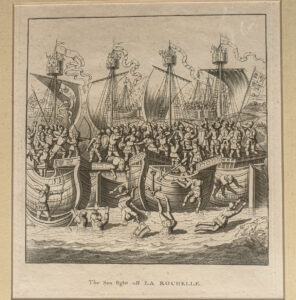Elizabeth Stewart's Blog, page 5
April 27, 2025
Brill Family Foundation Call for Artist
Peter Brill talks about the Brill Family Foundation‘s art show, Symbiosis or Schism: The AI Human Odyssey, which addresses how to help artists and art organizations adapt to this inevitable future world. They currently seek artist submissions for the exhibition by June 13th.
Watch Video

The post Brill Family Foundation Call for Artist appeared first on Elizabeth Appraisals.
April 22, 2025
250-Year-Old English Engraving Important to History
 DS sent me a 250-year-old English engraving titled The Sea Fight off La Rochelle. It illustrates an image reproduced from the 14th century books, Chronicles (1337-1410) by Jean Froissart. The engraving pictures a tragic/comic 14th century seamen falling from ships in droves during battle in the Hundred Years War. The four books comprising Henry Noel Humphrey’s 1848 reproductions of Froissart’s Chronicles is for sale in the form of four antique bound books, at Thorn Books in London, for $7,500.
DS sent me a 250-year-old English engraving titled The Sea Fight off La Rochelle. It illustrates an image reproduced from the 14th century books, Chronicles (1337-1410) by Jean Froissart. The engraving pictures a tragic/comic 14th century seamen falling from ships in droves during battle in the Hundred Years War. The four books comprising Henry Noel Humphrey’s 1848 reproductions of Froissart’s Chronicles is for sale in the form of four antique bound books, at Thorn Books in London, for $7,500.
This engraving is ONE of many plates from one of those volumes. Froissart’s engravings were reproduced in the 14th and 15th century. four hundred years later reproductions became available in the 19th century by two engravers (1820 and 1848). This little image is important in both the history of medieval war and nautical art history.
I didn’t find a comparable sale for this EngravingBut this image of drowning soldiers falling off single-masted ships was “reprised” in the early 19th century, and again in the mid-19th century from works “after” Froissart’s 14th century engravings. Nautical renderings like this are important historical narrative sources for maritime historians studying early battles, especially those during the Hundred Years War. But, DS, the remarkable part is the unflinching portrayal of the soldiers, weighed down in their armor, falling headfirst into the sea.
The 14th century artist Froissart depicted the “action” in stopwatch “real time,” dramatically, colorfully, humorously. Historians believe he was there. This engraving with its ‘action’ scene depicts the battle the 14th century artist witnessed himself. No third-party narrator could evoke that kind of clarity of imagery in action. The Siege of La Rochelle took place in 1372, at a time when often sailors didn’t know how to swim, as we see in this naïve, sad image.
In Defense of SwimmingUnless a medieval commoner worked as a fisherman or somewhere near water, few men swam. A woman in the water meant both she and the water became contaminated. They looked on nudity as a sin.
Pietro Monte, a Milanese fencing master who authored books about training for battle wrote in the 15th century in defense of teaching swimming. Especially if a father trained a young boy for the militia or battle, because swimming trains the arms for fencing. He wrote that swimming is one of the seven free arts of chivalric training, along with riding, shooting, dancing, climbing, fencing, wrestling, leaping, and hand to hand combat and jousting. This training enforced the chivalric code of conduct which flourished in the courtly circles of 13th century and onward in Europe. It emphasized the qualities expected of an ideal knight: courage, honor, courtesy, justice, and service to the weak, including women. The Pentangle on Sir Gawain’s shield in Sir Gawain and the Green Knight of the 14th century represents the five key points: friendship, generosity, chastity, courtesy, and piety.
As opposed to the dignified chivalric code expected of warriors, images like this engraving of a seminal sea battle show war at sea as terrifying. They fought hand to hand, in armor, with men at oars in small skiffs, and larger medieval ships with a single mast called a “cog.” The “cog” ship carried no cannon, but for battle purposes carried a ramrod, as well as iron and stone projectiles, shot from decks.
Cause of this Remarkable BattleThe Hundred Years War (1337-1453) was, classically, a conflict between the Kingdoms of England and France in the late Middle Ages. Edward III of England made a claim to the French throne, and France wanted sovereignty. The 100-year battle, fueled by nationalism on both sides, happened in a period when culture and language weren’t so easily distinguished between England and France. In the middle of the war a pandemic, called the Black Death, illustrates the link between a global pandemic and nationalistic retrenchment.
The 100 Year’s War became know as the Middle Age’s most famous conflict. Five generations of kings from England and France fought over the rulership of France, the wealthiest kingdom in Europe. The war was the largest conflict in European history. The result, after 116 years of war, against the English? The French forces remained in control of the Kingdom of France. Thus, France and England were from then on separate monarchies.
The post 250-Year-Old English Engraving Important to History appeared first on Elizabeth Appraisals.
April 21, 2025
Performing Arts Scholarship Foundation
Board President Deborah Bertling joins five young competitors, age ten and up, to talk about the Performing Arts Scholarship Foundation.
Watch Video

The post Performing Arts Scholarship Foundation appeared first on Elizabeth Appraisals.
Elizabeth Stewart's Blog
- Elizabeth Stewart's profile
- 5 followers



